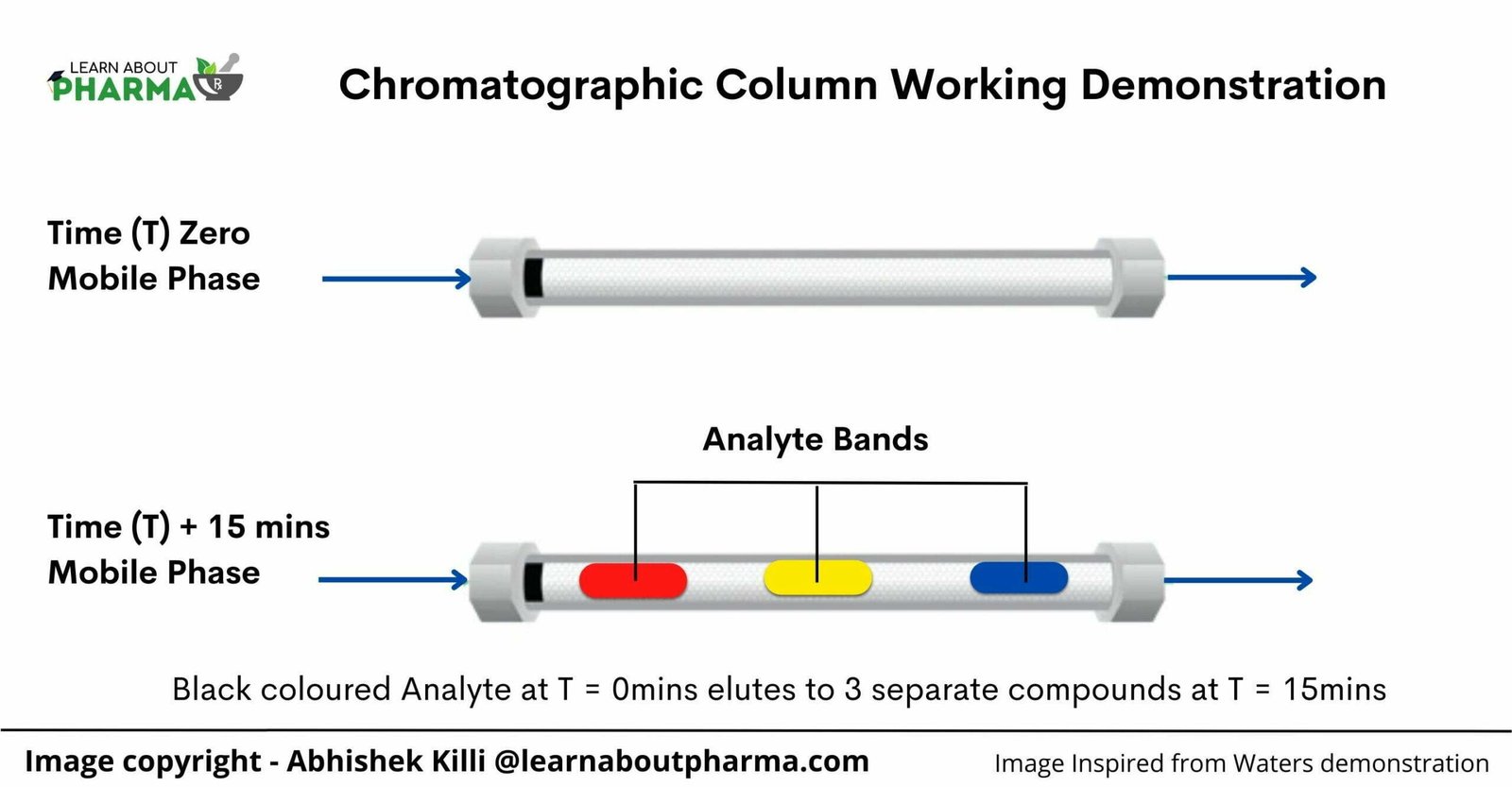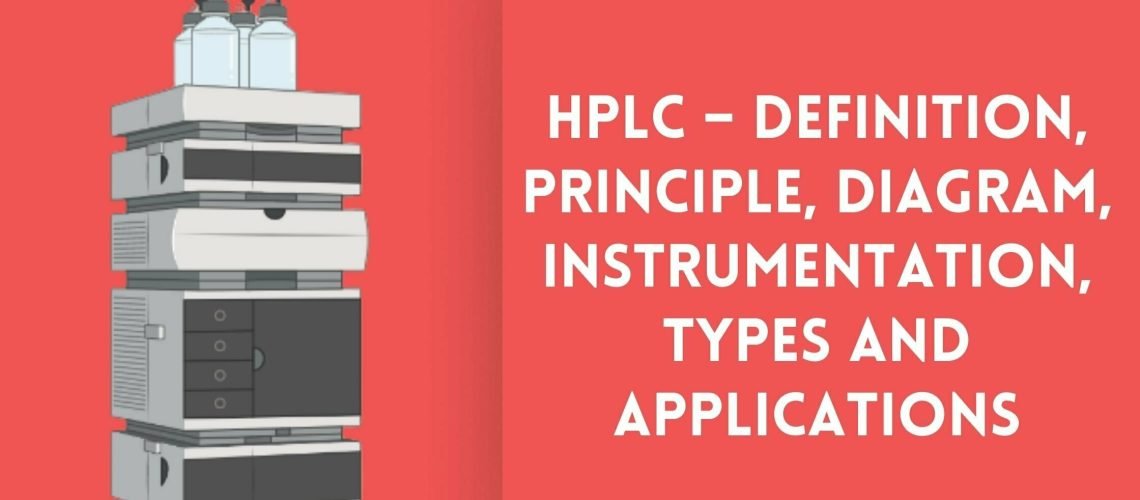What is High-performance liquid chromatography (HPLC)?
HPLC, aka High-Performance Liquid Chromatography, is a separation technique in analytical chemistry used to identify, quantify and separate molecular compounds in a liquid mixture. Liquid chromatography (LC) is a very well-established technique. HPLC is the most widely used LC technique in the pharmaceutical industry to identify and quantify compounds of interest.
Before understanding the principle of HPLC, first, we need to know about chromatography. Chromatography is an analytical process of separating components in a mixture. To initiate the process, a mixture of unknown components is dissolved in a substance known as mobile phase, which carries it through a solid second substance called the stationary phase. This mixture of unknown components travels through the stationary phase at variable speed, causing them to separate from one another. These different travel times are popularly known as the retention time (T + 15mins as shown in figure). The speed of the mixture is based on the polarity of the components in the mobile and stationary phases. The higher the polarity of the components, the faster it moves through the mobile phase and vice versa. The stationary phase constrains many of the components in a mixture, slowing them down to move slower than the mobile phase.

Out of all chromatography techniques, liquid chromatography (LC) is widely used across different industries. It is a separation technique in which the mobile phase is a liquid, where sample ions or molecules are dissolved. It is carried out either in a column or a plane. HPLC is an advanced and modified LC technique performed under a significantly higher operational pressure than LC. The conventional LC technique relies on the force of gravity to pass the mobile phase through the column resulting in a slow flow rate. On the other hand, HPLC solvent is forced through the column under high pressures up to 400 atmospheres, which increases the mobile phase flow rate, fastens the separation process, and thus increases efficiency.
Principle of High-Performance Liquid Chromatography (HPLC):

- The principle of separation on HPLC is based on the distribution of analyte (sample with a different unknown amount of compounds) between the mobile phase and stationary phase (column).
- Depending on the chemical structure of the analyte, the molecules are retarded in the column stationary phase due to specific intermolecular interactions between the analyte and the packing material on the column. This defines the analyte’s retention time on the column, and therefore different substances elute at different time intervals, thereby achieving the separation of different compounds in an analyte.
- The mobile phase is pressurized into the column using solvent delivery pumps with the stationary phase.
- An analyte sample with unknown compounds is injected into the mobile phase before entering the column.
- Subsequently, individual compounds in the analyte migrate through the column at different rates achieving separation.
- Once the analytes exit the column, the detector unit recognizes the compounds in the analyte and exhibits them in electrical signals. Such signals are fed to the computer data station in the HPLC to generate the chromatogram.
- Chromatograms are used to identify and quantitate the concentration of analyte constituents.
Instrumentation in the High-Performance Liquid Chromatography (HPLC)
Solvent delivery pump:
- Also known as a solvent delivery system, it is used to maintain a constant flow rate of the mobile phase through the HPLC system.
- The purpose of the pump is to force the mobile phase through the column while maintaining a specific flow rate.
- There are three HPLC pumps categories: Syringe, Reciprocating, and Pneumatic pumps. Out of these, reciprocating pumps are most commonly used due to their constant rate of pressure generation at any moment, small footprint, constant and reproducible flow rate,
- Before selecting a pump, certain things like instruments compatibility with different solvents, price, ease of use, cleanability, maintenance costs, etc., shall be considered.
Injector:
- An HPLC injector allows the introduction of samples onto the column. These injectors inject the sample without disturbing the flow rate and pressure of the HPLC system.
- The role of the injector has a lot of significance because direct injection of the sample is not suggested as the working pressure of the HPLC is adequately high that we cannot inject the sample into the mobile phase.
- Care must be taken while injecting the sample. Points that must be kept in mind like introducing a sample without air bubbles, a sample introduced with constant pressure and flow rate, injection volume of the sample is in microliters, and the sample must be free from any particulate matter.
- There are many conventional types of injectors like Rheodyne injector, Septum injector, and Stopflow injector; however, an advanced injector known as Auto-sampler injector is used to deliver an aliquot of sample to the HPLC column. It is high-tech automation equipment with high precision, variable volume, and long-term reliability.
HPLC Column:
- The hplc column is an integral part of the HPLC system that performs the critical task of separating molecular compounds during analysis.
- Several types of columns are used in the pharmaceutical industry; however, the most commonly used ones are C18 and C8 columns.
- Common packing materials in columns include silica or hydroxyapatite media and polymeric resins such as polystyrene divinylbenzene.
- Columns are made of stainless-steel housing or glass casing; however, housing made SS is considered the most stable and is tolerant towards a wide variety of solvents.
Detector:
- Detectors are used to sense the presence of separated compounds as they leave the column. The separates are monitored and expressed electronically by the detectors.
- Detectors used shall be sensitive, have good stability, reproducibility, inexpensive, non-destructive, highly reliable, and withstand temperatures ranging up to 400 deg.C.
- Detectors measure the difference in some physical properties of the solute in the mobile phase compared to the mobile phase alone.
Computer Data Station (Recorder)
- Electronic data signals expressed by the detectors are interpreted and processed into a meaningful inference in the form of chromatograms.
- They record the baseline and all the peaks obtained with respect to time.
- Present date data stations perform multiple complex tasks like data acquisition, interpretation, data processing, data storage, and distribution across the connected systems within an organization.
Degasser:
- The mixing of liquids involves the entrapment of gases like oxygen, which contributes to noise and causes an unstable baseline.
- Degasser is a high-efficiency in-line system designed to remove dissolved gases from a solvent.
- The degasser is easy to use, provides reliable continuous operation, and eliminates the need for helium sparging to remove gases.
- Polymeric Teflon tubing inside the degasser has micropores, which contribute to outward gaseous exchange to the environment while preventing any liquid from passing through the pores.
Column Heater:
- This accessory is used to precisely control the temperature of the analysis to improve the sensitivity, analysis time, and peak separation and ensure the accuracy of sample results.
- Column Heater provides consistent, reproducible temperature control for HPLC columns.
- The heater will produce temperatures between ambient +5° C to 150° C with an accuracy of ±2°C while operating in environments with temperatures between -5° C to 50° C.
Types of High-Performance Liquid Chromatography (HPLC)
Normal Phase chromatography:
- This chromatography type uses columns packed with a polar stationary phase and a nonpolar or moderately polar mobile phase to separate polar compounds.
- The polar stationary phase includes silica, alumina, or polar-bonded phase, whereas the nonpolar mobile phase includes hexane, heptane, etc.
- This method separates analytes based on polarity. Less polar solutes move the fastest and therefore exit the column and are detected first, followed by solutes of increasing polarity, which move more slowly.
- This technique is used for water-sensitive compounds, geometric isomers, class separation, and chiral compounds.
Reverse Phase Chromatography:
- This chromatography type uses columns packed with a nonpolar stationary phase and a moderately polar, aqueous mobile phase to separate polar, nonpolar, ionic, and ionizable compounds.
- It works on the principle of hydrophobic interactions.
- In this chromatography, the surface of the column stationary phase is covalently bound with alkyl or aromatic ligands to provide a hydrophobic surface. Hydrophobic solutes present in the mobile phase tend to get bound to the stationary phase via hydrophobic interactions, forming the basics of separation.
Ion Exchange Chromatography:
- Ion exchange chromatography (IEX) is a chromatographic separation method based on the protein’s net charge.
- IEX separates molecules by their surface charge, a property that can vary vastly between different proteins.
Size Exclusion Chromatography:
- Aka molecular sieve chromatography is a method where molecules in a solution are separated by their size and molecular weight.
- The separation is achieved by the attraction between solute ions and the charged sites bound to the stationary phase.
- It is usually applied to large molecules or macromolecular complexes such as proteins and industrial polymers.
Applications of the High-Performance Liquid Chromatography (HPLC)
- Detection of impurities in the pharmaceutical industry
- Water purification
- Qualitative and quantitative analysis
- To identify the purity of compounds
- Determination of mixture of drugs or multicomponent analysis
- Biochemical separations
- Find pollutants in Environmental samples
- Analysis of synthetic polymers
- Purification of compounds
- Analysis of products in the Pharmaceutical, biotech, and food industries
- Pre-concentration of trace elements
- Ion-exchange chromatography of proteins
- High-pH anion-exchange chromatography of carbohydrates and oligosaccharides
- Ligand-exchange chromatography
Advantages of High-Performance Liquid Chromatography (HPLC)
- Fastest and most precise analytical instrument to separate targeted compounds.
- Accurate and reliable
- Powerful and adaptable
Limitations of High-Performance Liquid Chromatography (HPLC)
- High maintenance costs
- Very complex to operate
- Needs competent and well-trained personnel to operate
- Volatile substances are not suitable for separation via HPLC
- Less sensitive for particular compounds and fails to detect in most cases.
References:
- Generalic, Eni. “Column chromatography.” Croatian-English Chemistry Dictionary & Glossary. 20 Oct. 2018. KTF-Split. 5 Jan. 2022. https://glossary.periodni.com
- https://www.bio-rad.com/webroot/web/pdf/lsr/literature/Bulletin_9188.pdf
- https://www.azom.com/article.aspx?ArticleID=8468
- https://www.thermofisher.com/blog/ask-a-scientist/what-is-chromatography/
- https://www.knauer.net/en/Systems-Solutions/Analytical-HPLC-UHPLC/HPLC-Basics–principles-and-parameters
- https://microbenotes.com/high-performance-liquid-chromatography-hplc
- https://laboratoryinfo.com/hplc/
- https://www.shimadzu.com/an/service-support/technical-support/analysis-basics/basic/what_is_hplc.html
- https://chrominfo.blogspot.com/2018/04/hplc-injector-and-types-of-hplc-injector.html



